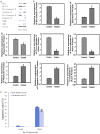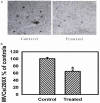Inhibition of glioblastoma growth and invasion by 125I brachytherapy in rat glioma model
- PMID: 28559975
- PMCID: PMC5446507
Inhibition of glioblastoma growth and invasion by 125I brachytherapy in rat glioma model
Abstract
Development of the novel targeted therapies for glioblastoma multiforme is very important. Brachytherapy has been proven to provide a good alternative to surgical removal of the prostate, breast and cervix with reduced risk of certain long-term side effects. Thus, 125I brachytherapy was used to effect on the growth and invasion of glioma cells in vitro and in vivo. The inhibitory effect of 125I seeds on C6 cells proliferation was determined by MTT assay. A rat intracranial glioma model was established and the 125I seeds were implanted into the glioma area. CD31 expression was determined by immunohistochemical method to evaluate the angiogenesis. The ΔΨm detection and cell invasion assays were performed to detect the mitochondrial-induced apoptosis and invasion signaling in tumor cells. 125I brachytherapy could significantly inhibit C6 rat glioma cells growth and reduce cell viability in vitro. The seeds implantation also inhibited tumor growth in the rat glioma model and improved survival rate. Analysis revealed that ROS production and the intrinsic mitochondrial pathway of apoptosis was activated by 125I brachytherapy. The HE staining results revealed that the rat glioma model treated with 125I seeds exhibited better defined tumor margins and fewer invasive cells to the lateral striatum compared with the untreated group. The comparison of expression of CD31 in treated or untreated groups was performed to show that the 125I brachytherapy has potential antiangiogenic activity. Meanwhile, 125I brachytherapy can inhibit the growth and invasion of glioma cells via decreasing the expression of MMP-2 and MMP-9.
Keywords: 125I brachytherapy; apoptosis; glioblastoma; invasion; mitochondrion.
Conflict of interest statement
None.
Figures






Similar articles
-
DYT-40, a novel synthetic 2-styryl-5-nitroimidazole derivative, blocks malignant glioblastoma growth and invasion by inhibiting AEG-1 and NF-κB signaling pathways.Sci Rep. 2016 Jun 2;6:27331. doi: 10.1038/srep27331. Sci Rep. 2016. PMID: 27251589 Free PMC article.
-
Flavonoids from the Amazon plant Brosimum acutifolium induce C6 glioma cell line apoptosis by disrupting mitochondrial membrane potential and reducing AKT phosphorylation.Biomed Pharmacother. 2019 May;113:108728. doi: 10.1016/j.biopha.2019.108728. Epub 2019 Mar 8. Biomed Pharmacother. 2019. PMID: 30856536
-
Tetraarsenic oxide-induced inhibition of malignant glioma cell invasion in vitro via a decrease in matrix metalloproteinase secretion and protein kinase B phosphorylation.J Neurosurg. 2014 Dec;121(6):1483-91. doi: 10.3171/2014.8.JNS131991. Epub 2014 Oct 10. J Neurosurg. 2014. PMID: 25303017
-
Rat C6 glioma as experimental model system for the study of glioblastoma growth and invasion.Cell Tissue Res. 2002 Dec;310(3):257-70. doi: 10.1007/s00441-002-0651-7. Epub 2002 Nov 6. Cell Tissue Res. 2002. PMID: 12457224 Review.
-
C6 cell line: the gold standard in glioma research.Hippokratia. 2018 Jul-Sep;22(3):105-112. Hippokratia. 2018. PMID: 31641331 Free PMC article. Review.
Cited by
-
125I seeds irradiation inhibits tumor growth and induces apoptosis by Ki-67, P21, survivin, livin and caspase-9 expression in lung carcinoma xenografts.Radiat Oncol. 2020 Oct 15;15(1):238. doi: 10.1186/s13014-020-01682-5. Radiat Oncol. 2020. PMID: 33059701 Free PMC article.
-
Radioactive Iodine-125 in Tumor Therapy: Advances and Future Directions.Front Oncol. 2021 Sep 30;11:717180. doi: 10.3389/fonc.2021.717180. eCollection 2021. Front Oncol. 2021. PMID: 34660280 Free PMC article. Review.
-
Mechanistic insights into 125I seed implantation therapy for Cholangiocarcinoma: focus on ROS-Mediated apoptosis and the role of GPX2.J Cancer Res Clin Oncol. 2024 Jun 25;150(6):324. doi: 10.1007/s00432-024-05840-0. J Cancer Res Clin Oncol. 2024. PMID: 38914724 Free PMC article.
-
Effects of radioactive 125I on apoptosis of HGC-27 gastric cancer cells.Oncol Lett. 2019 Nov;18(5):4916-4922. doi: 10.3892/ol.2019.10832. Epub 2019 Sep 9. Oncol Lett. 2019. PMID: 31612002 Free PMC article.
-
Radiobiology and modelling in Brachytherapy: A review inspired by the ESTRO Brachytherapy pre-meeting course.Clin Transl Radiat Oncol. 2024 Nov 8;50:100885. doi: 10.1016/j.ctro.2024.100885. eCollection 2025 Jan. Clin Transl Radiat Oncol. 2024. PMID: 39670056 Free PMC article. Review.
References
-
- Kleihues P, Louis D, Scheithauer B. The WHO classification of tumors of the nervous system. J Neuropathol Exp Neurol. 2002;61:215–225. - PubMed
-
- Qiang L, Yang Y, You QD, Ma YJ, Yang L, Nie FF, Gu HY, Zhao L, Lu N, Qi Q, Liu W. Inhibition of glioblastoma growth and angiogenesis by gambogic acid: an in vitro and in vivo study. Biochem Pharmacol. 2008;75:1083–1092. - PubMed
-
- Nieder C, Grosu A, Astner S, Molls M. Treatment of unresectable glioblastoma multiforme. Anticancer Res. 2002;25:4605–4610. - PubMed
-
- Stupp R, Mason W, van den Bent M. Radiotherapy plus concomitant and adjuvant temozolomide for glioblastoma. N Engl J Med. 2005;352:987–996. - PubMed
-
- Astner S, Pihusch R, Nieder C, Rachinger W. Extensive local and systemic therapy in extraneural metastasized glioblastoma multiforme. Anticancer Res. 2006;26:4917–4920. - PubMed
LinkOut - more resources
Full Text Sources
Miscellaneous
